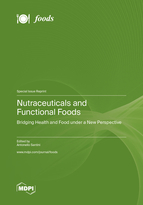Nutraceuticals and Functional Foods: Bridging Health and Food under a New Perspective
A special issue of Foods (ISSN 2304-8158). This special issue belongs to the section "Nutraceuticals, Functional Foods, and Novel Foods".
Deadline for manuscript submissions: closed (31 March 2022) | Viewed by 57384
Special Issue Editor
Interests: nutraceuticals; food chemistry; natural compounds; food supplements; food safety; medicinal chemistry; contaminants; secondary metabolites; functional food; biopolymers; nanomaterials
Special Issues, Collections and Topics in MDPI journals
Special Issue Information
Dear Colleagues,
It is my privilege to invite you to contribute to a new and very targeted Special Issue of Foods dedicated to nutraceuticals and functional foods. It is a novel project launched by Foods, unique in its characteristics, and dedicated entirely to cover high-level aspects of nutraceuticals and functional foods from different points of view in a novel approach targeting contemporary applications and their use in a global and interdisciplinary perspective.
This Special Issue aims to bridge food, nutraceuticals, and functional food in order to target a new frontier addressed but not limited to global food-related health issues.
Under this perspective, the relationships and interaction between them, the effect on the human organism, and the understanding of their mechanisms of action is of the utmost importance. The starting point might encompass definitions, regulations, analysis, chemical aspects, characterization, and the new features of nutraceuticals and functional foods, such as the emerging area of nanoformulations; their delivery, bioavailability, and bioaccessibility; as well as novel purpose-designed nutraceuticals and functional foods from known or novel food sources.
The categorization and classification of biologically active compounds, with particular regard to molecules of recent identification and which show great potential and effectiveness, are of interest for this Special Issue.
We welcome descriptions of the main food sources but also emerging ones (i.e., food wastes, unconventional foods, novel food sources, recovery from side- or by-products of the food system) with a view to sustainable, environmentally friendly recovery for the development and promotion of novel nutraceuticals and functional foods.
The health potential of nutraceuticals is a topic of great interest triggering research worldwide: this Special Issue would also welcome contributions addressing nutraceuticals and functional food mechanisms of action regarding also aspects connected to possible interactions with physiological processes or with other molecules or foodstuffs themselves, as well as the potential protective effects in model studies in vitro and in cell models, animal studies, and human studies to exploit their mechanisms of action and target to optimize delivery and appropriate formulation.
Based on this premise, new fields and new applications and emerging areas will be explored in this Special Issue, which hopes to include the evolution of this area based on its roots, but with an eye to the brilliant future ahead.
Prof. Dr. Antonello Santini
Guest Editor
Manuscript Submission Information
Manuscripts should be submitted online at www.mdpi.com by registering and logging in to this website. Once you are registered, click here to go to the submission form. Manuscripts can be submitted until the deadline. All submissions that pass pre-check are peer-reviewed. Accepted papers will be published continuously in the journal (as soon as accepted) and will be listed together on the special issue website. Research articles, review articles as well as short communications are invited. For planned papers, a title and short abstract (about 100 words) can be sent to the Editorial Office for announcement on this website.
Submitted manuscripts should not have been published previously, nor be under consideration for publication elsewhere (except conference proceedings papers). All manuscripts are thoroughly refereed through a single-blind peer-review process. A guide for authors and other relevant information for submission of manuscripts is available on the Instructions for Authors page. Foods is an international peer-reviewed open access semimonthly journal published by MDPI.
Please visit the Instructions for Authors page before submitting a manuscript. The Article Processing Charge (APC) for publication in this open access journal is 2900 CHF (Swiss Francs). Submitted papers should be well formatted and use good English. Authors may use MDPI's English editing service prior to publication or during author revisions.
Keywords
- Food and by-products
- Functional foods and novel sources
- Health and beneficial properties
- Nutraceuticals and novel sources
- Prevention
- Clinical data
- In vitro and in vivo data
- Nanonutraceuticals and nanodelivery
- Clinical experience
- Formulation and novel sources
- Mechanism of action
- Analytical aspects
- Safety
- Interactions with active molecules







